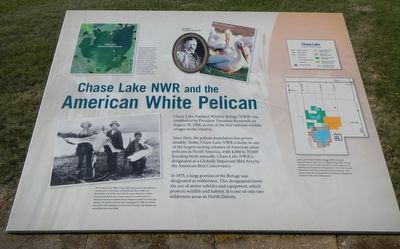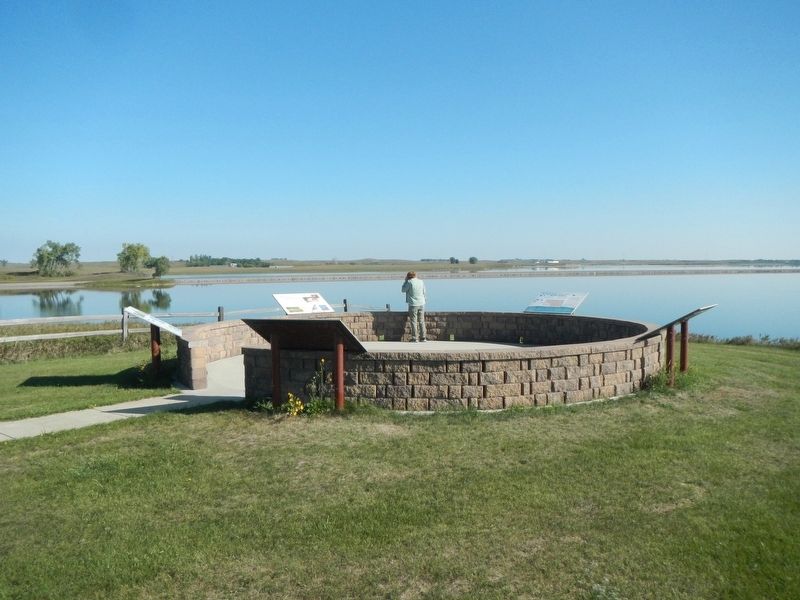Near Crystal Springs in Stutsman County, North Dakota — The American Midwest (Upper Plains)
Chase Lake NWR and the American White Pelican

Photographed By Barry Swackhamer, September 9, 2020
1. Chase Lake NWR and the American White Pelican Marker
Captions: (top left) President Theodore Roosevelt; American white pelican; Chase Lake NWR covers 4,385 acres of grassland and wetland habitat. The Refuge is home to American white pelicans and many other species of wildlife including black-crowned night-herons, California and ring-billed gulls, double-crested cormorants, piping plovers, Sprague'pipits, Le Conte's and Baird's sparrows, sharp-tailed grouse, and numerous other species.; (bottom left) As far back as the 1800s, Chase Lake was known as an important nesting area for American white pelicans. But in 1905, H.H. McCumber one of the area's first European American settlers, became concerned about over-hunting. He wrote to the U.S. Biological Survey and asked that a refuge be created to protect the pelicans. By the time the site was investigated in 1908, the pelican population had dropped to no more than 50 birds. The Refuge was established soon thereafter.; (right) Chase Lake National Wildlife Refuge (NWR) is located approximately 9 miles north of Crystal Springs WPA. Visitors are welcome, but it is also essential to protect pelicans from disturbances during their nesting season. From April through September, a permit is required to enter the Refuge. The permit is free and can be picked up at Refuge headquarters, located 5 miles east of Woodworth.
Since then, the pelican population has grown steadily. Today, Chase Lake NWR is home to one of the largest nesting colonies of American white pelicans in North America, with 4,000 to 35,000 (sic) breeding birds annually. Chase Lake NWR is designated as a Globally Important Bird Area by the American Bird Conservancy.
In 1975, a large portion of the Refuge was designated as wilderness. This designation limits the use of motor vehicles and equipment, which protects wildlife and habitat. It is one of only two wilderness areas in North Dakota.
Erected by North Dakota Fish and Wildlife.
Topics. This historical marker is listed in these topic lists: Environment • Parks & Recreational Areas. A significant historical date for this entry is August 28, 1908.
Location. 46° 52.431′ N, 99° 26.31′ W. Marker is near Crystal Springs, North Dakota, in Stutsman County. Marker is on Interstate 94 at milepost 223 near 47th Avenue Southeast, on the right when traveling west. The marker is located at the Crystal Springs/St. Paul Rest Area Westbound. Touch for map. Marker is in this post office area: Medina ND 58467, United States of America. Touch for directions.
Other nearby markers. At least 6 other markers are within 14 miles of this marker, measured as the crow flies. Chase Lake Prairie Project (here, next to this marker); The Missouri Coteau - North America's Duck Factory. (here, next to this marker); Welcome to Crystal Springs WPA (here, next to this marker); The National Wildlife Refuge System in North Dakota (about 400 feet away, measured in a direct line); Sibley Trail (approx. 12.1 miles away); Dr. J.S. Weiser (approx. 13.7 miles away).
Credits. This page was last revised on December 20, 2020. It was originally submitted on December 20, 2020, by Barry Swackhamer of Brentwood, California. This page has been viewed 107 times since then and 17 times this year. Photos: 1, 2. submitted on December 20, 2020, by Barry Swackhamer of Brentwood, California.
